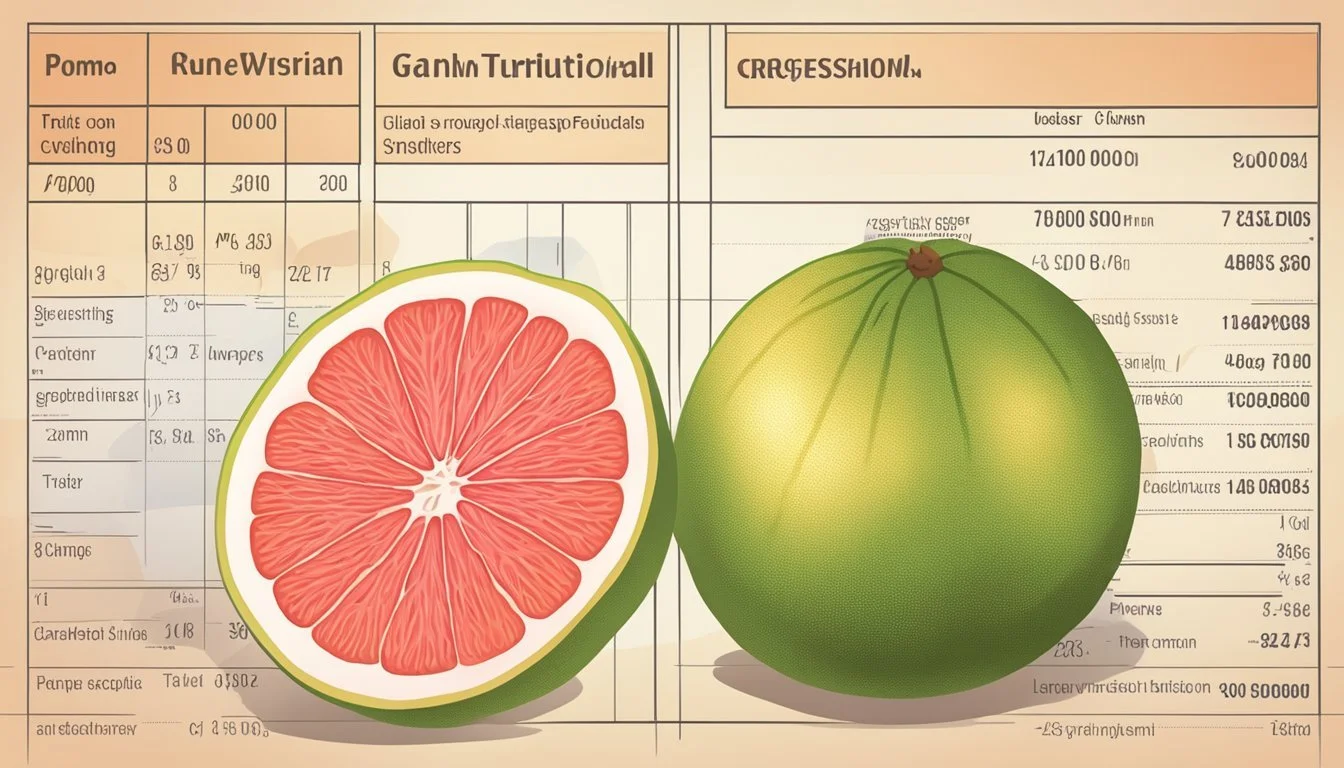How to Substitute Pomelo for Grapefruit
A Seamless Citrus Swap Guide
Substituting pomelo for grapefruit can be a simple task when understanding the similarities and differences between these two citrus fruits. Pomelos, the largest citrus fruit, can range from 7 to 10 inches in diameter and are known for their sweet and less bitter taste compared to grapefruits, which are smaller at about 4 to 6 inches in diameter. This mild sweetness of pomelo provides a unique twist to dishes typically using the sharper, more bitter grapefruit, while preserving a refreshing citrus flavor.
In cooking and baking, the textural difference between pomelo and grapefruit must also be considered. Pomelo has a thicker rind and a more fibrous texture within its segments. Its juicy content, though less than that of grapefruit, offers a substantial bite that can enhance the physical appeal of a salad or a fruit mix. Pomelo segments can offer a lighter, less intense citrus note to dishes where grapefruit could be overpowering, making it a versatile substitute in both savory and sweet recipes.
Because grapefruit can interact with certain medications, substituting pomelo offers a practical alternative for those facing dietary restrictions. Pomelo's rich vitamin C and potassium content makes it not just a flavorful substitute, but also a nutritionally beneficial one. Its carbohydrate count is higher, so portion control might be necessary for those monitoring their sugar intake. However, pomelo's low fat and protein content keep it in line with grapefruit as a low-calorie option suitable for various culinary uses.
Understanding Pomelo and Grapefruit
In order to effectively substitute pomelo for grapefruit, one should comprehend the fundamental characteristics and distinctions between these two citrus fruits, including their profiles, features, varieties, flavors, nutritional content, and culinary applications.
Citrus Fruit Profiles
Pomelo (Citrus maxima or Citrus grandis) is the largest citrus fruit, typically measuring 7 to 10 inches in diameter with a thick and spongy rind. The flesh of the fruit can be white, pink, or red depending on the variety. Grapefruit (Citrus x paradisi), on the other hand, averages between 4 to 6 inches in diameter and typically has a thinner rind with pink or ruby flesh, although white varieties are also common.
Distinctive Features of Pomelo
Pomelos have a pear or globe shape, boasting a thick rind that ranges from pale yellow to greenish-yellow. The rind is tough, which provides good protection to the inner segments. The texture of pomelo flesh is more firm compared to grapefruit, and the segments are often larger.
Grapefruit Varieties
There are several types of grapefruit, each with unique characteristics. Varieties include Ruby Red with deep red flesh, Pink with a lighter red or pink flesh, and White grapefruit, which tends to be more acidic. The skin color can vary from yellow to pinkish, and some varieties have a smoother texture than others.
Taste and Flavor Comparison
Pomelo is often milder and sweeter, with a less acidic profile than grapefruit, leading to a subtler, less tart taste. Grapefruit typically has a stronger sweet-tart flavor balance, with a noticeable bitterness that is appreciated in many dishes and beverages.
Nutritional Benefits and Content
Both pomelo and grapefruit are high in vitamin C and low in calories, making them a nutritious choice. A serving of grapefruit contains about 13 grams of carbohydrates and is rich in fiber and antioxidants. Pomelo provides a substantial amount of both vitamin C and potassium, and has more carbohydrates, about 59 grams per serving, yet they both are low in fat and protein.
Nutrient Pomelo (per serving) Grapefruit (per serving) Carbohydrates 59 grams 13 grams Vitamin C High High Potassium Good amount Lesser amount Fiber Moderate High Antioxidants Present Rich Fat Low Low Protein Low Low
Common Uses in Cooking and Beverages
Pomelo is customarily used in salads, desserts, and Asian cuisines, where its sweet flavor and firm flesh can stand out. Grapefruit, with its bold, zingy flavor, is popular in breakfasts, salads, and also as a base for citrus-infused drinks and cocktails due to its pronounced acidity and strong citrus essence.
Substituting Pomelo for Grapefruit
When substituting pomelo for grapefruit, one must consider both the flavor and texture differences to maintain the integrity of the dish. This section outlines specific guidelines to successfully incorporate pomelo as an alternative to grapefruit in various recipes.
Culinary Considerations
Pomelo is the larger cousin of the grapefruit with a sweeter and milder taste. When using pomelo in place of grapefruit, chefs should be aware of the subtle flavor differences. Pomelo tends to be less bitter and more floral in flavor than grapefruit, which may affect the desired taste profile of a dish.
Adjusting Recipes for Taste and Texture
Pomelo has a thicker rind and drier flesh compared to grapefruit. To adjust recipes, reduce the amount of sweetness if the meal calls for grapefruit's tartness. Additionally, the texture of pomelo is firmer, so it might need to be macerated or softened for certain preparations that require the soft texture grapefruit provides.
Substitution Ratios
In general, one can substitute pomelo for grapefruit in equal proportions by volume or weight. For example, if a recipe requires one cup of grapefruit segments, one can use one cup of pomelo segments instead.
Salads and Dressings
Salads benefit from the sweet, mild taste of pomelo. Replace grapefruit segments with pomelo segments directly, keeping in mind that pomelo's sweetness might necessitate a slight increase in acidic components in the dressing, such as lime or orange juice, to balance flavors.
Marinades and Citrus-based Sauces
For marinades and sauces where grapefruit juice is a component, use pomelo juice as a one-to-one substitute. The more subtle flavor of pomelo can complement the other ingredients without overpowering them. However, chefs may need to adjust other seasoning components like salt or chili to align with pomelo's sweeter profile.
Desserts and Fruit Dishes
In desserts, pomelo can successfully replace grapefruit. Its sweeter segments make it a pleasant addition to fruit salads, tarts, and cakes. Since pomelo is less juicy, recipes might require additional moisture from other citrus fruits, such as oranges, to compensate.
Pomelo Preparation Techniques
When substituting pomelo for grapefruit, proper preparation is essential to maximize flavor and texture. This section focuses on the best techniques for peeling and segmenting, juicing, as well as incorporating pomelo into various recipes.
Peeling and Segmenting
To peel a pomelo, one should cut off the top and bottom to create a stable base. The peel is quite thick, so cutting through the rind until the pink or pale yellow flesh is visible is necessary. Once the top and bottom are removed, careful vertical cuts should be made to remove the peel in sections. Then, using a spoon or fingers, the pith is separated from the fruit segments. For presentation or certain recipes, it's best to remove individual segments from the membrane for a clean look.
Juicing Methods
Juicing a pomelo can be a bit more challenging due to its thick rind and drier pulp compared to grapefruit. After segmenting the pomelo, one can hand-squeeze the juice or use a juicer to extract it. For hand-squeezing, apply steady pressure to the segmented fruit over a bowl or use a hand-held citrus juicer to help break the sacs and release the juice. If using a juicing machine, ensure the peeled segments are free of excess pith to avoid bitterness in the juice.
Incorporating into Recipes
Pomelo is versatile and can be included in a variety of recipes as a grapefruit substitute. Its sweet and mildly tart flavor makes it perfect for salads, desserts, and citrus-infused dressings. When using pomelo in recipes, consider its texture, which tends to be firmer and less juicy, meaning it might not release as much liquid into the dish. One should finely chop or slice the pomelo segments to match the texture expected from grapefruit. Pomelo juice can also be used in cocktails, marinades, or sauces, imparting a distinct, aromatic citrus flavor.
Comparative Nutritional Analysis
When substituting pomelo for grapefruit, it's essential to understand their nutritional profiles. Both fruits offer unique benefits, with differences in vitamins, minerals, calorie count, and dietary fiber that can affect health outcomes.
Vitamin and Mineral Content
Pomelos are an excellent source of vitamin C, providing about twice as much vitamin C as grapefruits. This is significant because vitamin C is crucial for the immune system, skin health, and iron absorption. Additionally, pomelos contain higher levels of iron compared to grapefruits.
Pomelo: Rich in vitamin C and iron
Grapefruit: Good vitamin C content but less iron
Dietary Fiber and Caloric Value
Grapefruit contains lower calories and carbohydrates, making it a suitable option for low-calorie diets. However, both fruits are low in fat and protein, which is typical for citrus fruits. The dietary fiber content in both pomelos and grapefruits contributes to heart health and digestion.
Pomelo: Higher in carbohydrates with significant dietary fiber
Grapefruit: Fewer calories and carbs, with a modest amount of fiber
Health Implications of Consumption
The health benefits of consuming either fruit include contributions to heart health and the immune system. Due to their fiber content, they can aid digestion and potentially help in weight management. The sugar content is another consideration; while both fruits contain natural sugars, pomelo has a higher sugar content, which may impact blood sugar levels.
Pomelo: Higher sugar and vitamin C content
Grapefruit: Lower in calories; beneficial for immune and heart health
Cultural and Market Considerations
When substituting pomelo for grapefruit, it's important to consider how the fruits are perceived and used in various cultures, their availability during different seasons, and the financial impact of such substitutions.
Pomelo and Grapefruit in Different Cuisines
In Southeastern Asia, particularly in countries like Malaysia, the pomelo is a staple in both sweet and savory dishes. Its sweet, less acidic flavor complements spicy flavors and is featured in traditional salads like the Thai 'Yum Som-O,' which often includes shrimp and coconut, providing a balance to the dish's spicy-sour profile. Grapefruit, though more readily available in Western markets such as California, is less common in Asian cuisines but is similarly utilized in salads and can be paired with avocado for a refreshing twist.
Availability and Seasonality
The market availability of pomelo and grapefruit varies significantly:
Pomelo: Predominantly grown in Southeastern Asia, pomelo has a peak season from November to March. It's also cultivated to a lesser extent in California.
Grapefruit: More widespread in American markets, grapefruit is typically in season from September to April, with some varieties available year-round.
When substituting pomelo for grapefruit outside of their typical seasons, one might experience limited availability and potential cost increases.
Cost Implications of Substituting
The cost of pomelos and grapefruits can differ based on several factors:
Demand: A lower demand for pomelos in Western markets can lead to higher prices compared to grapefruits.
Origin: Import costs for pomelos from Southeastern Asia can contribute to higher retail prices.
Species and Varieties: Less common varieties of either fruit may carry premium prices due to rarity or specialized cultivation methods.
In financial terms, substituting grapefruit for pomelo might be more cost-effective in Western markets, while the reverse could be true in Asian regions.
Conclusion
Substituting pomelo for grapefruit requires consideration of flavor, size, and texture. Pomelos are larger than grapefruits and offer a sweeter and milder taste. They can be effectively used in recipes calling for grapefruit, particularly where a less tart flavor is desired.
When substituting in recipes:
Salads: Use pomelo segments for a sweeter touch.
Baked goods: Adjust sugar content if substituting pomelos for grapefruit to avoid excess sweetness.
Sauces and dressings: Pomelo juice can be used in place of grapefruit juice; start with less and taste as you go.
Keep in mind the textural differences:
Pomelos have thicker pith and membranes, which may need to be removed.
Grapefruits are juicier and may contribute more liquid to a dish.
Nutritional Considerations:
Both fruits are rich in vitamin C.
Pomelos contain more carbohydrates.
Caloric content may vary slightly, though both are typically low in calories.
Substitutions may affect the recipe’s intended flavor balance. For precise recipes or those heavily dependent on the acidity of grapefruit, consider the impact of using a milder citrus like pomelo. In most cases, pomelos serve as a suitable alternative, enhancing dishes with a unique and delightful citrus essence.






